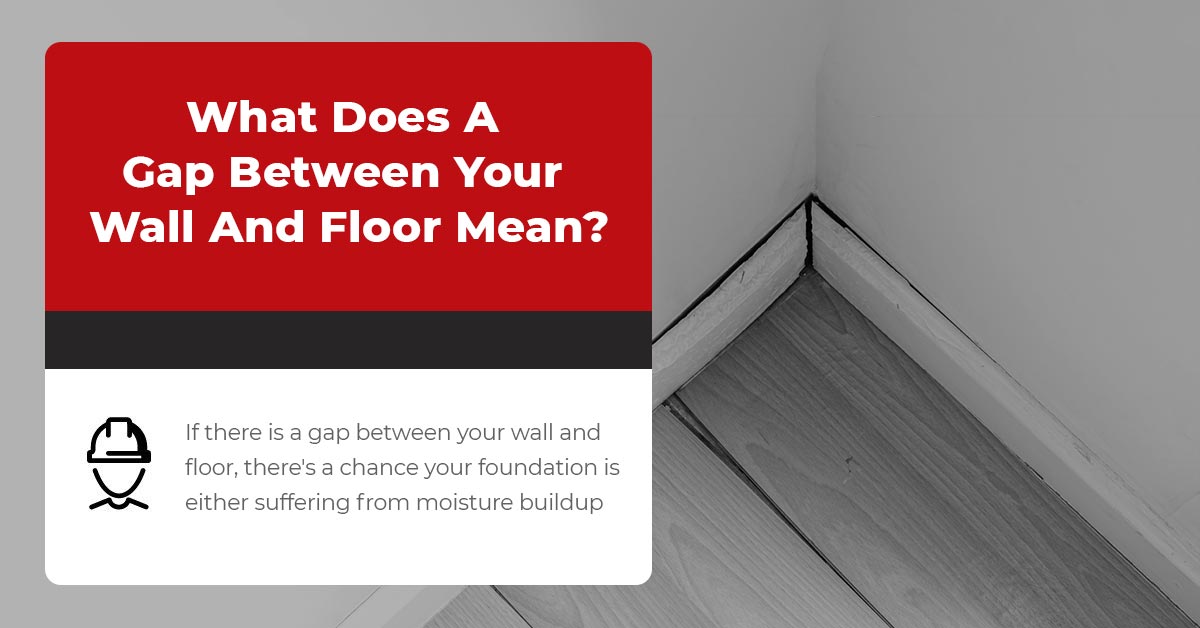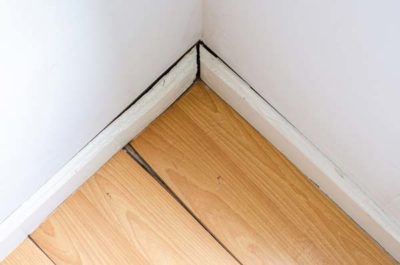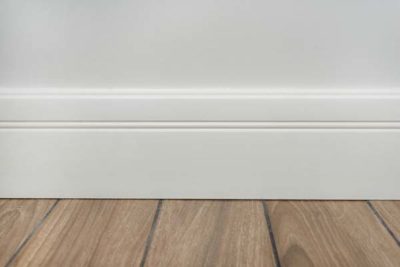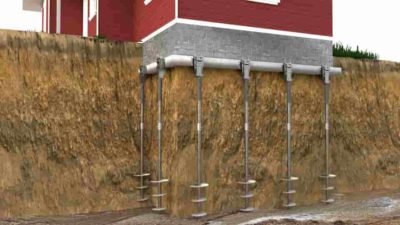If there is a gap between your wall and floor, there’s a chance your foundation is either suffering from moisture buildup or settlement. This article explains how moisture inside your foundation affects the rest of your home and how weak soil can leave gaps between your wall and floor. Some articles will tell you how to fill the gap with caulk, but this hides the problem without solving the actual issue.
A Gap Between Your Wall And Floor Means Moisture
If your home has a basement or crawl space, a gap between your wall and floor could mean moisture is building up inside your foundation. If you’ve been inside your basement or crawl space and looked up, you’ll see the wooden joists and floor boards beneath your first level.
When moisture builds up inside your foundation, the air molecules will rise and stick to your wooden supports. If you have fiberglass insulation on your basement or crawl space ceiling, moisture builds up inside the material, leading to mold growth.
The real issue is the warping when wood and water meet. This will shift your hardwood, vinyl, or tile floors, leaving gaps. It can also rot the wooden posts holding up your crawl space, leading to dips and bows. Read more: How To Replace A Rotten Floor Joist In A Crawl Space.
Here’s how water enters your basement and solutions that stop the problem.
- Over-the-top seepage – Water can enter your foundation using the space between your first floor and basement wall.
- Cove joint seepage – Water can enter your foundation using the space between your basement floor and the basement wall.
- Egress windows – Water can enter your basement using gaps in improperly sealed egress windows.
- Honeycombing – Water can use patches of deteriorating concrete to enter your basement or crawl space.
- Cracks – Water can use cracks in your basement or crawl space walls to enter your foundation.
- Pipe penetration – Water can enter your foundation using improperly filled gaps around plumbing pipes that lead into your basement or crawl space.
Solution: Foundation Waterproofing
If experts determine that there are gaps between your walls and floor because of moisture issues in your basement or crawl space, they’ll recommend foundation waterproofing. Complete foundation waterproofing involves a combination of multiple solutions.
- Fill any cracks and honeycombing concrete with an epoxy injection to keep water from seeping into your foundation.
- Fill gaps around pipes using expanding polyurethane epoxy to seal the area, prevent water seepage, and still allow some pipe movement.
- Install a drain tile system inside or outside the foundation walls, collecting built-up ground and diverting it away from the concrete.
- Install a sump pump to eject the collected water away from the home and foundation.
- Install a vapor barrier to catch moisture seeping through the concrete foundation, allowing it to drop into the drain tile below.
A Gap Between Your Wall And Floor Means Settlement
A gap between your wall and floor can also mean your home is settling into the soil below it. Most homes settle slightly after about two years once they’ve experienced different seasons and temperatures. This is called uniform settlement and should only be within fractions of an inch. Anything larger than this is called differential settlement, meaning something is wrong with the soil below your foundation. Here are a few reasons why your home settles.
- Too much water – When water saturates the soil near your foundation, it can cause multiple issues. The first problem is hydrostatic pressure. This is when your foundation walls become a floodgate, trying to keep built-up water from entering your home. When the pressure becomes too much, your walls can bow and crack. This problem can even worsen if the saturated soil freezes, increasing the soil’s density.
- Too much clay – Soil that contains mostly clay is called expansive soil because of its sponge-like qualities. The soil will swell up when it’s filled with water, pushing or lifting your foundation. Then, when the water dries, the soil shrinks, allowing your foundation to fall back into place. This back-and-forth movement is not good for your foundation.
Solution: Underpinning
If experts determine that your foundation is sinking, leaving gaps between your wall and floor, they’ll use underpinning to lift and stabilize your foundation. Underpinning was first invented in Italy during the 1950s, becoming one of the most trusted forms of foundation settlement repair. There are two primary forms of underpinning: push piers and helical piers.
- Push piers are pushed into the soil below your foundation, one section at a time until they reach a level of stronger soil than the weaker soil above.
- Helical piers are drilled into the soil below your foundation like corkscrews.
Both pier systems are anchored to your foundation footers. Once the piers reach the necessary depth, hydraulic jacks push down onto the piers and use the pressure to lift your foundation.
Who Can Help You?
Underpinning and foundation waterproofing are not DIY projects that you can learn online. You need professional solutions from Foundation Professionals Of Florida. Based in Lake City, Florida, we serve all of the Southeastern United States, including the U.S. Virgin Islands. We provide all of the solutions mentioned above. Don’t wait. Call today for your free inspection and estimate.




